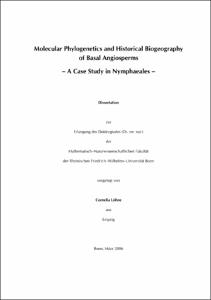Molecular Phylogenetics and Historical Biogeography of Basal AngiospermsA Case Study in Nymphaeales

Molecular Phylogenetics and Historical Biogeography of Basal Angiosperms
A Case Study in Nymphaeales

| dc.contributor.advisor | Barthlott, Wilhelm | |
| dc.contributor.author | Löhne, Cornelia | |
| dc.date.accessioned | 2020-04-10T14:33:46Z | |
| dc.date.available | 2020-04-10T14:33:46Z | |
| dc.date.issued | 2007 | |
| dc.identifier.uri | https://hdl.handle.net/20.500.11811/3076 | |
| dc.description.abstract | Scientific progress during the last two decades has greatly improved our knowledge on phylogenetic relationships among major lineages of flowering plants. Besides the two major groups of angiosperms, the eudicots and the monocots, there are several not closely related lineages that are generally referred to as the "basal angiosperms". Among those lineages, Amborella, Nymphaeales and Austrobaileyales are currently assumed to be successive sisters to the rest of angiosperms, thus forming a "basal grade". However, the phylogenetic relationships among and within the basal angiosperm lineages are still not convincingly resolved, which is to a large extent due to the persisting need for efficient molecular markers at this taxonomic level. The focus of the present thesis is on the phylogenetic and biogeographic history of the order Nymphaeales, a relatively small order comprising water lilies and other water plants. To clarify the phylogeny of Nymphaeales a new molecular marker, the petD intron, was developed. The molecular evolution of this non-coding region of the chloroplast genome was examined and its suitability as a new marker for resolving basal angiosperm relationships was proved. This study also revealed a great potential of microstructural changes as phylogenetic markers. In a second step the petD intron was chosen as a marker - together with other fast evolving chloroplast regions (rpl16 intron, trnK intron, matK gene, and the trnT-trnF region) to elucidate details of phylogenetic relationships in Nymphaeales. With this comprehensive analysis of Nymphaeales the monophyly of the Cabombaceae could be confirmed, but there is no convincing support for the monophyly of Nymphaeaceae with respect to Nuphar. Furthermore, the genus Nymphaea is inferred to be polyphyletic with respect to the genera Ondinea, Victoria and Euryale. In fact, Victoria and Euryale are inferred to be closely related to a clade comprising all night blooming water lilies (Nymphaea subgenera Hydrocallis and Lotos). The Australian endemic Ondinea forms a highly supported clade with the Australian water lilies Nymphaea subg. Anecphya. A detailed examination of relationships among Australian water lilies using chloroplast and nuclear markers (ITS, trnT-trnF) confirmed the close affinity of Ondinea to N. subg. Anecphya, and within this subgenus especially to Nymphaea hastifolia. The ITS data set resolved two well supported clades in Anecphya, the small-seeded and large-seeded group, with Ondinea and N. hastifolia being part of the small-seeded group. Observed polymorphisms among ITS paralogues points to recent hybridisation or introgression in this group. The rather young radiation of water lilies in Australia gave rise to one of the centres of diversity in Nymphaeales. Other centres of diversity are northern South America and South-Central Africa, which correspond to likewise recent radiations in the water lily subgenera Hydrocallis and Brachyceras. The radiation of core Nymphaeaceae, i.e. Nymphaea, Victoria, Euryale and Ondinea, occurred in the Tertiary around the Eocene-Oligocene boundary and is correlated with strong global cooling, the demise of the boreotropical flora and the segregation of northern hemispheric continents. The northern hemisphere, and possibly also South America, is inferred to be the ancestral range of Nymphaeales. Other Gondwanan continents such as Africa or Australia have been invaded by water lilies rather recently. Some findings of this thesis are of more general significance - beyond Nymphaeales or basal angiosperms: The present study provides another peace of evidence for the general utility of non-coding, fast-evolving chloroplast genomic regions and of microstructural changes as phylogenetic markers. Furthermore, the Nymphaeales study exemplifies the importance of judicious taxon sampling for correct phylogenetic inference. Only the combination of well-supported evidence from molecular phylogenetics, earth history and the fossil record with a thorough consideration of biological and ecological factors allows reasonable conclusions on the evolution of a lineage in space and time. | en |
| dc.language.iso | eng | |
| dc.rights | In Copyright | |
| dc.rights.uri | http://rightsstatements.org/vocab/InC/1.0/ | |
| dc.subject | Pflanzen | |
| dc.subject | Systematik | |
| dc.subject | Phylogenie | |
| dc.subject | Biogeographie | |
| dc.subject | Plastiden-DNS | |
| dc.subject | Intron | |
| dc.subject | Nymphaeaceae | |
| dc.subject | Seerosengewächse | |
| dc.subject | Angiospermae | |
| dc.subject | systematics | |
| dc.subject | phylogeny | |
| dc.subject | biogeography | |
| dc.subject | chloroplast DNA | |
| dc.subject | noncoding | |
| dc.subject | waterlily | |
| dc.subject | angiosperms | |
| dc.subject.ddc | 580 Pflanzen (Botanik) | |
| dc.title | Molecular Phylogenetics and Historical Biogeography of Basal Angiosperms | |
| dc.title.alternative | A Case Study in Nymphaeales | |
| dc.type | Dissertation oder Habilitation | |
| dc.publisher.name | Universitäts- und Landesbibliothek Bonn | |
| dc.publisher.location | Bonn | |
| dc.rights.accessRights | openAccess | |
| dc.identifier.urn | https://nbn-resolving.org/urn:nbn:de:hbz:5N-10051 | |
| ulbbn.pubtype | Erstveröffentlichung | |
| ulbbnediss.affiliation.name | Rheinische Friedrich-Wilhelms-Universität Bonn | |
| ulbbnediss.affiliation.location | Bonn | |
| ulbbnediss.thesis.level | Dissertation | |
| ulbbnediss.dissID | 1005 | |
| ulbbnediss.date.accepted | 30.05.2006 | |
| ulbbnediss.institute | Mathematisch-Naturwissenschaftliche Fakultät : Fachgruppe Biologie / Nees-Institut für Biodiversität der Pflanzen | |
| ulbbnediss.fakultaet | Mathematisch-Naturwissenschaftliche Fakultät | |
| dc.contributor.coReferee | Borsch, Thomas |
Files in this item
This item appears in the following Collection(s)
-
E-Dissertationen (4458)




